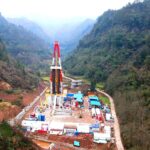The Rise of Geothermal Power
Geothermal power has long been an underappreciated player in the renewable energy landscape. However, its potential is vast, and its adoption is on the rise. In 2020, geothermal energy accounted for 12% of the world’s renewable power generation, with a total capacity of 13.4 gigawatts (GW).
How Geothermal Power Works
Principle and Technology
Geothermal power harnesses the natural heat from the Earth’s core to generate electricity. This heat is used to produce high-pressure steam, which drives a turbine to generate electricity. The process is simple, yet elegant. Drill a well, extract hot water or steam, and convert it into electricity.
Types of Geothermal Systems
There are three main types of geothermal systems: hydrothermal, geothermal, and enhanced geothermal systems (EGS). Hydrothermal systems rely on underground water to transfer heat to the surface. Geothermal systems use hot rock formations to generate steam. EGS, the most promising, uses a combination of water and rock to produce steam.
The Benefits of Geothermal Power
Low Carbon Emissions
Geothermal power is an extremely low-carbon source of energy, emitting only 13-39 grams of CO2 per megawatt-hour (MWh). This is a significant reduction from the 744 grams of CO2 per MWh emitted by traditional fossil fuels.
Reliability and Flexibility
Geothermal power plants can run continuously, providing reliable baseload power. They are also capable of responding quickly to changes in demand, making them an excellent addition to a diverse energy mix.
Job Creation and Economic Benefits
The geothermal industry creates jobs, stimulates local economies, and generates significant tax revenue. In the United States, for example, the geothermal industry supports over 4,000 jobs and contributes $1 billion to the economy annually.
Challenges and Opportunities
Exploration and Development Costs
Drilling and exploring for geothermal resources can be costly, with some projects requiring significant upfront investment. However, advances in technology and improved exploration methods are reducing these costs.
Regulatory Frameworks
In many countries, regulatory frameworks are still evolving, requiring governments to adapt and create supportive policies to encourage the growth of the geothermal industry.
Scalability and Integration
While geothermal power has the potential to scale, it is crucial to integrate it with other renewable energy sources, such as solar and wind, to create a diversified energy mix.
Conclusion
Geothermal power is an often-overlooked, yet vital, component of the renewable energy landscape. Its benefits, including low carbon emissions, reliability, and job creation, make it an attractive option for a sustainable energy future. As the world transitions to a low-carbon economy, geothermal power is poised to play a significant role in the global energy mix.
FAQs
Q: What is the largest geothermal power plant in the world?
A: The largest geothermal power plant in the world is the Olkaria I Power Plant in Kenya, with a capacity of 105 MW.
Q: What is the most suitable region for geothermal power generation?
A: Regions with high geothermal potential include the Pacific Ring of Fire (USA, Japan, Philippines, Indonesia), Africa (Kenya, Ethiopia, Tanzania), and the Americas (Mexico, California, Nevada, New York). Europe also has significant potential, particularly in Italy, France, and Iceland.
Q: How much does it cost to build a geothermal power plant?
A: The cost of building a geothermal power plant varies depending on the location, technology, and scale. On average, the cost ranges from $1,000 to $3,000 per kilowatt (kW), making it comparable to other renewable energy sources like solar and wind.
Q: What is the current market share of geothermal power in the world’s energy mix?
A: Geothermal power currently accounts for around 12% of the world’s renewable energy mix, with a total capacity of 13.4 GW.


_1.png?w=150&resize=150,150&ssl=1)
_1.png?w=150&resize=150,150&ssl=1)


